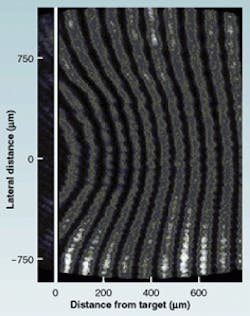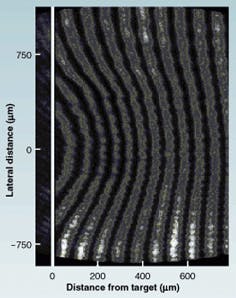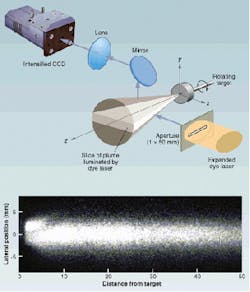Intensified CCDs investigate 0plasma plumes
Geoff Martin and Al Mottola
Ultrafast gated ICCD detectors allow real-time monitoring of pulsed-laser deposition and exploration of the plume-formation process.
Pulsed laser deposition (PLD) has been used to deposit high-quality films of materials for more than a decade. The technique uses high-power laser pulses (on the order of 108 W/cm-2) to melt, evaporate, and ionize material from the surface of a target. This ablation event produces a transient, highly luminous plasma plume that expands rapidly away from the target surface. The ablated material is collected on an appropriately placed substrate upon which it condenses and a thin film grows.
Applications range from the production of superconducting and insulating circuit components to improved wear and biocompatibility for medical applications. Despite this widespread use, the fundamental processes occurring during the transfer of material from target to substrate are not fully understood and are consequently the focus of much research.
FIGURE 1. Interferogram of a magnesium plasma plume expanding into vacuum was taken 46 ns after the ablation pulse struck the target surface. Laser fluence is 2.0 ±0.2 J/cm2 on the target; ICCD gate width is 2 ns.
The intensified charge-coupled device (ICCD) is well suited to high-speed synchronized transient detection. First, it combines all the benefits of a low-noise cooled CCD detector with internal gain. Thus, a detected photon signal is boosted to levels that exceed the noise floor of subsequent signal-processing electronics. This increases the signal-to-noise ratio without the need for long integration times. Second, the ICCD intensifier tube can operate as an ultrafast shutter when its gate potential is switched on and off. Typical optically measured gate time for an ultrafast ICCD is approximately 1.4 ns. This gating allows continuous emission from dynamic events to be probed in specific, well-timed windows.
For experiments that have a continuous-wave ultraviolet background, gating the microchannel plate is required for high on/off ratio to compensate for the energetic nature of the ultraviolet photons. The on/off ratio can be boosted to as high as 107:1 in the ultraviolet. Such a device can monitor PLD plumes and help in the understanding of the physical process of plume formation.
Brief history of PLD
The interaction of laser radiation with solid surfaces was under investigation from as early as 1962, when the emission spectrum of material vaporized by laser pulses was analyzed.1 The first demonstration of PLD in 1965 did not produce significant interest, as the films deposited were inferior to those obtained via other deposition techniques, such as chemical-vapor deposition or molecular-beam epitaxy.2 The technique remained dormant for about 20 years until researchers found that PLD could produce films of the high-temperature superconducting material yttrium barium copper oxide.3 The films obtained were superior in quality to those previously grown with other deposition methods and triggered worldwide interest in the technique. Current research applications include growing films for magneto-optic storage devices, developing multilayer devices for x-ray optics, and depositing diamond films on components for protection and insulation.
In principle, PLD is an extremely simple techniquepulses of laser energy remove material from the surface of a target. The vaporized material, which contains neutrals, ions, and electrons and is known as a laser-produced plasma plume, expands rapidly away from the target surface (velocities typically 106 cm/s in vacuum). Film growth occurs on a substrate upon which some of the plume material recondenses.
In practice, however, the situation is not so simple, with a large number of variables affecting the properties of the film, such as laser fluence, background gas pressure, and substrate temperature. These variables allow the film properties to be manipulated somewhat to suit individual applications. However, optimization can require a considerable amount of time and effort. Indeed, much of the early research into PLD concentrated on the empirical optimization of deposition conditions for individual materials and applications, without attempting to understand the processes occurring as the material is transported from target to substrate.
FIGURE 2. Laser-induced-fluorescence (LIF) measurements were taken with an experimental setup containing an ICCD (top). An LIF image of ground-state singly ionized titanium ions within a plume was recorded with a 5-ns ICCD gate width (bottom). Laser fluence was 5.1 ±0.2 J/cm2.
The technique of PLD has advantages over other film-deposition methods that include stoichiometric transfer of material from target to substrate, deposition rates of hundreds of angstroms per minute, and deposition in both inert and reactive background gases without the need to break vacuum when changing between materials.4 Even with these benefits, industrial uptake of PLD has been slow, and to date most applications have been confined to the research environment.
There are a few reasons for this. First, the plasma plume created during the laser-ablation process is highly forward-directed; therefore, the thickness of material collected on a substrate is highly nonuniform, and the composition can vary across the film. The area of deposited material is also quite small, typically on the order of 1 cm2, in comparison to that required for many industrial applications that need area coverage of around 7.5 x 7.5 cm2. The ablated material also contains macroscopic globules of molten material up to approximately 10 µm in diameter. The arrival of these particulates at the substrate is obviously detrimental to the properties of the film being deposited. In addition, the fundamental processes, occurring within the laser-produced plasmas, are not fully understood; thus, deposition of novel materials usually involves a period of empirical optimization of deposition parameters.
To a large extent, all problems but the last have been worked out. The last problem will be resolved by the development of computer simulations that will describe PLD and improve understanding of the fundamental physics and chemistry involved in the deposition process. However, a large amount of experimental data, obtained under accurately controlled and defined conditions, is required to assist the verification of such models.
Plasma-plume investigations
The PLD process can be crudely split into two segments: the plasma creation and expansion, followed by film growth at the substrate. It is the initial stage that benefits from the use of an ICCD.
The temporal evolution of densities, temperatures, and velocities within laser-produced plasmas can only be determined using diagnostics at nanosecond time scales, due to the high luminosity and transient nature of the plumes. A variety of techniques, including interferometry, optical spectroscopy, and laser-induced fluorescence (LIF), make possible the investigation of different stages of the plasma creation and expansion.
At delay times of approximately
100 ns after the ablation pulse, the free-electron component within the plume expanding into vacuum has been measured by Mach-Zehnder interferometry. The time-varying electron density was calculated from a series of interferograms of the plume, captured using an ICCD with a 2-ns gate width (see Fig. 1 on p. 115). The plume emits high-intensity broadband emission during the initial stages of the expansion, which could easily saturate the detector. However, the short gate width of the ICCD blocks out the majority of this continuum emission, enabling the interferogram to be extracted from the larger background signal. Snapshots show measurable electron densities extending out to 1 mm from the target at these delays, with peak densities greater than 1017/cm-3.5
At longer delays (and under similar conditions), LIF can map the neutral and ionic components within slices of a plume (see Fig. 2 on p. 116). Once again the short gate width is required to extract the relatively weak LIF signal from the more-intense plasma self-emission. The signal was observed to extend beyond 50 mm at 3-µs delay, with peak densities of approximately 1010/cm-3 (obtained using a combination of LIF and absorption spectroscopy data).5
Data from these diagnostics helped researchers to construct an overall picture of the plume expansion for comparison with models of the laser-ablation process. Such examples show both the species density and spatial extent of the plume varying over several orders of magnitude during a time scale of less than a few microseconds, illustrating the flexibility required from both the diagnostics and detectors used in such experimental investigations.
As understanding of the plasma processes increases, investigations and computer models may be applied to more-complex systems and will include the deposition stage of the process. It is hoped that eventually the computer simulations will help predict what happens when novel materials are deposited using PLD. Fast ICCDs will continue to be the detector of choice for acquiring the data necessary to develop these computer models, with their role perhaps changing to in situ monitors for process control, once PLD becomes commercially viable for industrial applications.
GEOFF MARTIN is engineering coordinator at Andor Technology Ltd., 9 Millennium Way, Springvale Business Park, Belfast, N. Ireland. AL MOTTOLA is senior application specialist at Andor Technology, 168 Rt. 526, Allentown, NJ 08501; e-mail: [email protected].
REFERENCES
- F. Breech and L. Cross, Appl. Spectrosc. 16, 59 (1962).
- H. M. Smith and A. F. Turner, Appl. Opt. 4, 147 (1965).
- D. Dijkamp et al., Appl. Phys. Lett. 51, 619 (1987).
- D. B. Chrisey and G. K. Hubler, Pulsed Laser Deposition of Thin Films, Wiley, New York (1994).
- G. W. Martin et al., Appl. Surf. Sci. 127-129, 710 (1998).


